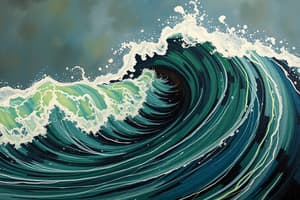Podcast
Questions and Answers
What geological feature is most commonly associated with earthquakes?
What geological feature is most commonly associated with earthquakes?
- Mountains
- Volcanoes
- Canyons
- Fault lines (correct)
What is the name of the instrument used to record ground-shaking activity from earthquakes?
What is the name of the instrument used to record ground-shaking activity from earthquakes?
- Hygrometer
- Seismograph (correct)
- Barometer
- Thermometer
Which type of seismic wave travels the fastest?
Which type of seismic wave travels the fastest?
- S-wave
- Rayleigh wave
- P-wave (correct)
- Love wave
Which seismic wave is known for causing the most damage?
Which seismic wave is known for causing the most damage?
What kind of motion do Love waves produce?
What kind of motion do Love waves produce?
Who developed the Richter Scale?
Who developed the Richter Scale?
On the Richter scale, what does each whole number increase represent?
On the Richter scale, what does each whole number increase represent?
Which scale is preferred for measuring high-magnitude earthquakes?
Which scale is preferred for measuring high-magnitude earthquakes?
What is the term for the recording made by a seismograph?
What is the term for the recording made by a seismograph?
What type of material can S-waves travel through?
What type of material can S-waves travel through?
Flashcards
Seismic Activity
Seismic Activity
Vibrations or disturbances to the Earth's surface, often occurring at fault lines where tectonic plates meet and interact.
Seismograph
Seismograph
An instrument that records ground-shaking activity caused by earthquakes.
Seismic Waves
Seismic Waves
Waves that originate from the center of an earthquake and travel outward.
Body Waves
Body Waves
Signup and view all the flashcards
P-Waves (Primary Waves)
P-Waves (Primary Waves)
Signup and view all the flashcards
S-Waves (Secondary Waves)
S-Waves (Secondary Waves)
Signup and view all the flashcards
Surface Waves
Surface Waves
Signup and view all the flashcards
Love Waves
Love Waves
Signup and view all the flashcards
Rayleigh Waves
Rayleigh Waves
Signup and view all the flashcards
Richter Scale
Richter Scale
Signup and view all the flashcards
Study Notes
- Earth's crust is divided into moving plates that meet at fault lines, where earthquakes commonly occur.
- Earthquakes result from the plates rubbing, pressing, sliding against each other, causing surface vibrations.
- Seismic activity study the size, type and frequency of earthquakes
Measuring Earthquakes
- Earthquakes originate underground; seismographs measure ground-shaking activity on the surface.
- Seismographs are also called Seismometers.
- Seismometers have internal mass/pendulum attached to a spring, moving with ground movement.
- Seismograms are the recordings made by the seismograph.
Seismic Waves
- Seismic waves originate at the earthquake's center and radiate outward.
Body Waves
- Travel through the Earth's interior.
- P-waves (Primary waves) are fast, longitudinal compression waves.
- S-waves (Secondary waves) are slower, transverse waves that cause more damage.
- P-waves compress ground, while S-waves move in an up-and-down motion.
- S-waves travel only through solids and are absorbed by Earth's liquid outer core.
Surface Waves
- Cause the most damage and move along the Earth's surface.
- Love waves are the fastest, moving in a snake-like, horizontal motion.
- Rayleigh waves move like S-waves on the surface, causing significant shaking.
Measuring Earthquakes
- Seismograms help determine an earthquake's location, size, and strength (magnitude).
Richter Scale
- Developed in 1935 by Charles Richter.
- Uses the base-10 logarithm of the largest wave's amplitude on a seismograph.
- Each whole number increase represents a ten-fold increase in magnitude.
- Originally designed for magnitudes 3-7, now has a wider range.
- An earthquake measured at 6.1 is considered to be medium to strong.
Moment Magnitude Scale
- Preferred for high-magnitude earthquakes.
- Measures seismic movement, not just wave amplitude.
- Used to measure earthquakes higher than 8.
- Calculated using fault line information and seismic activity.
Studying That Suits You
Use AI to generate personalized quizzes and flashcards to suit your learning preferences.




